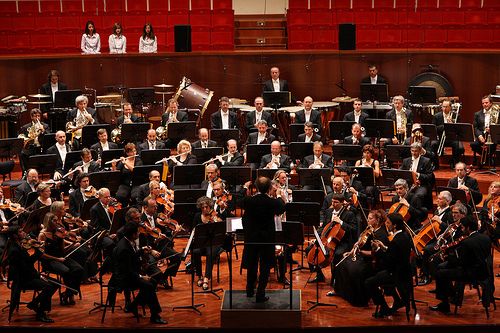
Neuroscience
The Brain is an Orchestra
Advances in technology allow scientists to hear the symphony
Posted November 15, 2013
Imagine you are listening to a symphony. But instead of hearing the entire orchestra playing, you can only hear the percussion section.
By itself, the sound of the percussion section does not make sense. It would sound like random booms, bangs, and clangs. But when you hear the entire orchestra play together, the sound is recognizable as music.
Your brain is an orchestra, and each neuron is an instrument.

An orchestra is an ensemble of instruments, including string, bass, woodwind, and percussion sections.
Traditionally, neuroscience has focused on individual neurons. Traditionally, neuroscience has just listened to the percussion section.
Of course science has know for a long time that the brain is an orchestra and all neurons matter, but the best tools available enabled recording from a single or just a few neurons.
In the analogy where a neuron is one instrument (a drum for example), neuroscientists have been able to ask, “What does the drum beat sound like in this situation? How does this stimulus change the drum beat?”
These “one neuron, one behavior” studies are useful, and they are frequently cited within the science community and often written up in the popular press.
Of course neuroscience has know for a long time that the brain is actually an entire orchestra, but the best tools available just enabled recording from single neurons, or listening to just one instrument or section.
Not any more. Technology is allowing neuroscience to undergo a seismic shift.
The hardware used to measure the electrical activity of neurons has improved, and now data from many neurons can be collected simultaneously. Computers can now handle enormous amounts of data, and they can analyze it quickly.
It is becoming possible to listen to the orchestra.
A group of Stanford University neuroscientists recorded simultaneously from a population of neurons in the prefrontal cortex and then used computers to analyze that data all at once, at the population level. Valerio Mante, David Sussillo, Krishna Shenoy, and William Newsome’s paper, “Context-dependent computation by recurrent dynamics in prefrontal cortex,” was published in the Nov. 7th issue of Nature.
This elegant study asked the question of how a population of prefrontal cortex neurons guided behavior in two different situations. When considering the entire orchestra at once, instead of just what the drums were doing, the researchers discovered something novel about how the prefrontal cortex works. What the neuronal population was doing together was not detectable in single neurons. They could not discern music from just the percussion section.
Now imagine trying to understand complex mental diseases, such as a psychiatric disorder. What if a diseased brain is not missing a percussion section, but instead the disease manifests as a percussion section that is out of sync with the rest of the orchestra?
The only way you could search for an out of sync percussion section is by having the capabilities to listen to the entire orchestra, by recording from neuronal populations and analyzing that data as the ensemble it really is.

